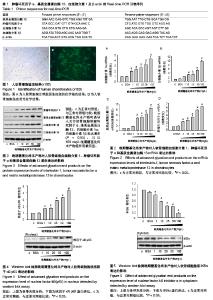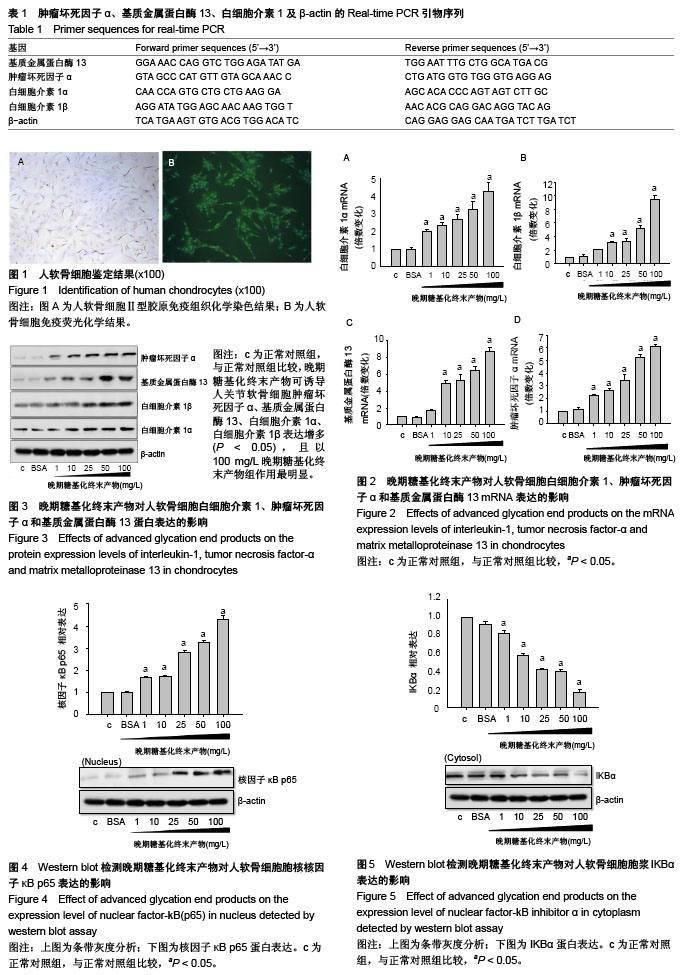| [1] Li MH, Xiao R, Li JB, et al.Regenerative approaches for cartilage repair in the treatment of osteoarthritis. Osteoarthritis Cartilage. 2017;25(10):1577-1587.[2] Flemming, DJ,Gustas-French CN. Rapidly Progressive Osteoarthritis: a Review of the Clinical and Radiologic Presentation.Curr Rheumatol Rep. 2017;19(7):42.[3] Chen C, Ma C, Zhang Y,et al.Pioglitazone inhibits advanced glycation end product-induced TNF-alpha and MMP-13 expression via the antagonism of NF-kappaB activation in chondrocytes.Pharmacology.2014;94(5-6):265-272.[4] Yang Q, Chen C, Wu S, et al.Advanced glycation end products downregulates peroxisome proliferator-activated receptor gamma expression in cultured rabbit chondrocyte through MAPK pathway.Eur J Pharmacol. 2010;649(1-3): 108-114.[5] Yan JY, Tian FM, Wang WY, et al. Age dependent changes in cartilage matrix, subchondral bone mass, and estradiol levels in blood serum, in naturally occurring osteoarthritis in Guinea pigs.Int J Mol Sci.2014;15(8):13578-13595.[6] Musumeci G,Szychlinska MA,Mobasheri A. Age-related degeneration of articular cartilage in the pathogenesis of osteoarthritis: molecular markers of senescent chondrocytes. Histol Histopathol.2015;30(1):1-12.[7] Li Y,Wei X,Zhou J,et al.The age-related changes in cartilage and osteoarthritis.Biomed Res Int.2013;2013:916530.[8] Serrao PR,Vasilceac FA,Gramani-Say K,et al.Expression of receptors of advanced glycation end product (RAGE) and types I, III and IV collagen in the vastus lateralis muscle of men in early stages of knee osteoarthritis. Connect Tissue Res.2014;55(5-6):331-338.[9] Yang Q,Guo S,Wang S,et al.Advanced glycation end products-induced chondrocyte apoptosis through mitochondrial dysfunction in cultured rabbit chondrocyte. Fundam Clin Pharmacol.2015;29(1):54-61.[10] DeGroot J, Verzijl N, Wenting-van Wijk MJ, et al.Accumulation of advanced glycation end products as a molecular mechanism for aging as a risk factor in osteoarthritis.Arthritis Rheum.2004;50(4):1207-1215.[11] Leong DJ,Sun HB.Events in articular chondrocytes with aging. Curr Osteoporos Rep.2011;9(4):196-201.[12] Chen YJ,Sheu ML,Tsai KS,et al.Advanced glycation end products induce peroxisome proliferator-activated receptor gamma down-regulation-related inflammatory signals in human chondrocytes via Toll-like receptor-4 and receptor for advanced glycation end products.PLoS One.2013;8(6):e66611.[13] 向登,蒋涛,贺军,等.塞来昔布对不同程度骨关节炎患者TNF-α、IL-1β及PGE-2的影响[J].中国骨与关节损伤杂志,2016,31(05): 496-498.[14] 陈铖,马翅,张莹,等.AGEs对兔软骨细胞TNF-α和MMP-13表达的影响及其机制研究[J].湖南师范大学学报:医学版,2013,(04): 23-28[15] Chen JR,Takahashi M,Suzuki M,et al.Comparison of the concentrations of pentosidine in the synovial fluid, serum and urine of patients with rheumatoid arthritis and osteoarthritis. Rheumatology (Oxford).1999;38(12):1275-1278.[16] Aldini G,Vistoli G, Stefek M, et al. Molecular strategies to prevent, inhibit, and degrade advanced glycoxidation and advanced lipoxidation end products. Free Radic Res.2013;47 Suppl 1:93-137.[17] Nowotny K,Jung T,Hohn A, et al. Advanced Glycation End Products and Oxidative Stress in Type 2 Diabetes Mellitus. Biomolecules.2015;5(1):194-222.[18] Lee JJ,Wang PW,Yang IH,et al.Amyloid-beta mediates the receptor of advanced glycation end product-induced pro-inflammatory response via toll-like receptor 4 signaling pathway in retinal ganglion cell line RGC-5.Int J Biochem Cell Biol.2015;64:1-10.[19] Badger AM, Griswold DE, Kapadia R, et al. Disease- modifying activity of SB 242235, a selective inhibitor of p38 mitogen-activated protein kinase, in rat adjuvant-induced arthritis. Arthritis Rheum. 2000; 43(1):175-183.[20] Mavunkel BJ, Chakravarty S, Perumattam JJ, et al. Indole-based heterocyclic inhibitors of p38alpha MAP kinase: designing a conformationally restricted analogue. Bioorg Med Chem Lett. 2003;13(18):3087-309. |

